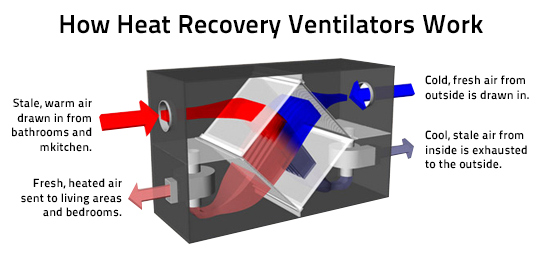Why HRV Is a Smart Investment for Modern Homeowners
Exploring the Benefits of Heat Recovery Ventilation for Energy Effectiveness in Residences
Heat Recovery Ventilation (HRV) systems use property owners a useful strategy to improving energy efficiency. By recovering warmth from outward bound air, these systems can considerably decrease heating & cooling prices. Additionally, they provide a constant supply of fresh air, boosting indoor air quality and comfort levels. As home owners think about lasting options, understanding the nuances of HRV systems comes to be significantly vital. What factors should one review before making such an investment?
Comprehending Heat Recovery Ventilation Solutions

How HRV Enhances Indoor Air High Quality

Energy Cost Savings: The Monetary Benefits of HRV
Making the most of power efficiency, heat recovery ventilation (HRV) systems use significant financial advantages for property owners. By recovering and recycling warm from exhaust air, HRVs significantly reduce heating & cooling prices. This technology can result in power cost savings of as much as 30%, relying on climate and use patterns. Homeowners commonly discover reduced utility costs quickly after setup, making he said HRVs an economically sensible investment gradually. Additionally, lots of areas provide incentives or refunds for energy-efficient upgrades, additionally improving the financial appeal. As energy rates remain to climb, the cost-effectiveness of HRVs comes to be significantly clear. In general, the consolidation of HRV systems not only advertises energy effectiveness but also adds to long-term financial savings for households.
The Environmental Impact of Heat Recovery Ventilation
A significant ecological benefit of heat recovery ventilation (HRV) systems lies in their ability to decrease overall energy consumption. By redeeming warmth from exhaust air and transferring it to inbound fresh air, HRV systems reduce the requirement for energy-intensive heating and cooling techniques. This decrease in power demand adds to reduce greenhouse gas discharges, as much less nonrenewable fuel source is required to keep comfy interior temperature levels. Additionally, HRV systems improve interior air quality by effectively exchanging stagnant air with fresh outdoor air, decreasing dependence on mechanical air conditioning systems that can harm the setting. In general, the execution of HRV systems supports lasting living methods and aligns with global initiatives to battle environment adjustment by advertising energy efficiency in property settings.
Choosing the Right HRV System for Your Home
Just how can property owners guarantee they choose the appropriate heat recovery ventilation (HRV) system for their needs? First, they see need to assess their home's dimension and format, as these variables influence airflow requirements. Next off, reviewing the system's performance scores is crucial, as greater rankings suggest much better efficiency and power savings. Homeowners need to additionally think about installation and upkeep prices, contrasting different brand names and designs for value. Additionally, it is necessary to review sound levels, as some systems run more quietly than others. Consulting with heating and cooling specialists can offer customized recommendations based on details home problems. Lastly, examining user reviews and warranties can assist in making an informed choice, making sure that the picked HRV system successfully improves indoor air high quality and energy performance.
Regularly Asked Questions

Exactly how Typically Should I Tidy or Keep My HRV System?
The frequency of cleansing or preserving a heat healing air flow (HRV) system normally depends upon usage and ecological variables. Typically, it is advisable to carry out maintenance every six months to assure peak performance and air high quality.

Can HRV Solutions Help In Reducing Moisture Degrees Inside?
HRV systems can effectively decrease interior moisture levels by exchanging stagnant, damp air with fresh, drier air from outside. HRV Heat Recovery Ventilation. This process aids keep a balanced indoor atmosphere, improving convenience and stopping moisture-related problems
What Is the Life expectancy of a Typical HRV System?
The lifespan of a typical heat recovery ventilation (HRV) system differs, generally lasting in between 10 to 15 years. Regular upkeep can extend its efficiency and operational click to find out more life, making sure peak performance throughout its use period.
Are There Any Kind Of Sound Interest In HRV Solutions?
Noise worries with HRV systems can emerge, specifically from follower operation. However, many modern devices are made to minimize audio levels, guaranteeing they run silently while preserving efficiency, which attends to possible disruptions in living atmospheres.
Can I Set Up an HRV System Myself, or Do I Required a Specialist?
The private contemplated whether to set up the heat recovery ventilation (HRV) system personally or work with an expert. Generally, while DIY installment is feasible, competence warranties correct performance and compliance with regional building ordinance, improving system efficiency.